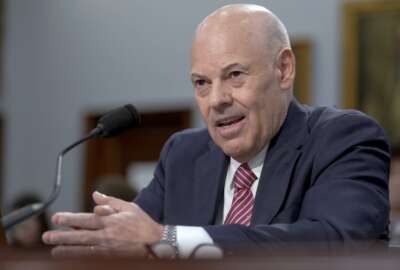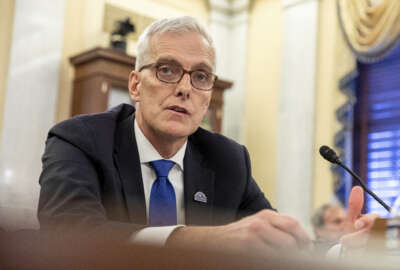Hubbard Radio Washington DC, LLC. All rights reserved. This website is not intended for users located within the European Economic Area.
GSA makes a try at co-working spaces for a new generation
"GSA previously had a telework program for co-working space in the 1990s that stopped in 2011 due to high maintenance costs," David Marroni said.
It never caught on with the Pepsi generation, maybe it will this time: federal co-working spaces. In a test program the General Services Administration has had underway for more than a year, people are using it, but the GSA in the opinion of the Government Accountability Office needs more data to fully assess the program. The GAO’s acting director of physical infrastructure, David Marroni, joined the Federal Drive with Tom Temin to discuss more.
Interview transcript:
Tom Temin Mr. Marroni, good to have you back.
David Marroni Happy to be here.
Tom Temin Let’s begin with the fact that GSA tried co-working, I think it was during the Clinton administration. Didn’t get a whole lot of take up, did it, at that time?
David Marroni That’s correct. GSA previously had a telework program for co-working space in the 1990s that stopped in 2011 due to high maintenance costs. And also that was when telework expanded residentially. And so you didn’t need those type of telework centers anymore.
Tom Temin And things have changed now. Well, in some sense post-COVID, but people are still teleworking a great deal. What’s their motivation for doing it now, do you think?
David Marroni So this is an effort by GSA to see what tools they can provide to agencies when they’re planning for their office space that could make things more efficient. So just one tool in the toolbox. But the idea is these co-working locations would enable agencies as they’re shedding leased space, as they’re reconfiguring their space to have a location where workers can go to for a number of months or maybe if they’re getting rid of their space on a more permanent basis while they’re teleworking at home. If they need to come in for training, if they need to go have particular meetings, they could share this space with other agencies rather than having to lease space of their own.
Tom Temin Yes. And looking at these statistics that you report through August 1 at least, well, let’s say roughly a thousand users from 59 federal entities have visited federal co-working spaces 2,000 times. Rounding up a little bit. That doesn’t sound like much.
David Marroni So it is still a pilot. And that’s part of what GSA is doing with this program, is to assess employee and agency interest in using these type of spaces. It is just at six locations across the country right now, and they are in the first year of a three-year pilot to assess is this a useful tool or not? So the answer isn’t known yet on that front.
Tom Temin Right. And in the 1990s, I guess it was the idea was big buildings that were around the outskirts of metropolitan areas on the predication that people didn’t want to have the traffic issues so they could go closer in the suburbs and they were big facilities in this case. Are they still trying that approach or is it little more modest in terms of the physical infrastructure, so to speak, that they’re using?
David Marroni So it’s more modest under the pilot. These are six office locations, generally centrally located. The purpose is different. So the 1990s version was exactly what you described, trying to provide office space that was further out for the core for folks who are coming in and maybe less on their commute, make it more convenient for them to come into the office. The effort now is again more about buying agencies with tools to shed office space that they don’t need and save money. And so several of these locations are actually in downtown cause it’s not so much about meeting distance, it’s more about sharing the space and trying to reduce these costs.
Tom Temin And before we get to your evaluation of of their evaluation of the program, which is really what your report is about, you could say, I mean, I’m just guessing here, but say a thousand people from 59 from 59, 60 agencies is what? You know, 100. And so people from each place have tried it. If you could get rid of the space required by 50, 60 people, that could actually leverage into hundreds of thousands of leased square feet of space that the government could potentially shed.
David Marroni Right. If this tool works for agencies as part of their long term space planning, you definitely could save shed a lot of space, save a lot of money either as a way, again, to be a swing space that, for instance, you are moving to a smaller space and you have a gap between leases or even if you’re going to a more remote work model, but you still need some ability for folks to come into the office at points in time during the year. This might also be a potentially good approach.
Tom Temin All right. And your report this time wasn’t really looking at whether the program’s any good, but more at GSA’s evaluation of it. Fair to say?
David Marroni Yes. We were looking at the extent to which they’ve designed this pilot in the most effective way possible so they can learn what they need to when they’re making the final decision in a couple of years.
Tom Temin Right. And they’re pretty good. They had measurable objectives. They have good stakeholder communication and they have an evaluation plan, which is part of best practices for any program, but scalability criteria. You said that did not work here. What do you mean by scalability criteria and what’s the issue?
David Marroni Yeah, that’s a mouthful. And basically what we mean by scalability criteria is good pilot programs early on know these are the metrics we’re going to use to decide whether we expand the pilot or contract the pilot and also whether we make it just part of our normal operations. Does the pilot essentially succeed and become part of how we do business? GSA hasn’t established those type of criteria for this pilot yet. They are still in the first year and they have been focused on coming up with a pricing structure right now. Our agencies don’t have to pay to use the space. They will. But based on our prior work we found you’d still need to have this kind of criteria early on so you can collect the type of information you need to make those decisions about. Do we add another pilot location in another city? Are we making the progress we need to to say this is a success or is this something that’s just not going to work?
Tom Temin We were speaking with David Marroni, acting director of physical infrastructure issues at the Government Accountability Office. I guess that’s kind of a natural human phenomenon as to hold off. What you need to know to decide whether to keep going because these programs, any federal program that started in an agency tends to have a bias toward continuing indefinitely no matter what. And I guess that’s kind of what you’re getting at. That should not happen here.
David Marroni Right? You need clear benchmarks to say this is this is a go no go for either expanding or contracting the pilot. And how are we going to decide if we’re going to keep this longer? It’s really important to have those in place.
Tom Temin And you also said that they need a little bit more data than they’re actually collecting pursuant to that scalability criteria decision.
David Marroni Right. They need some better data right now. They do. When someone comes into one of these co-working locations, they use a QR code to scan and check it. And that is how GSA counts that someone actually showed up at the space. That person also then gets sent a survey where they provide feedback on the program, which is another really important data point. However, there’s no requirement for that person to actually scan that. So if they come in there and they just don’t scan it, they just go to their desk, do their work and then leave. You might undercount the number of people who are using the facilities and you may not get their feedback or the full feedback you need from the number of users. So our recommendation to simply find ways to tighten up that data collection. So when you are making these decisions, you have the full set of data and the full set of feedback.
Tom Temin Seems like log on to the machines in those places would be a good way to get for sure who was when, who was doing what, when and where.
David Marroni That’s that’s a potential approach. You could use badging as well. You could use potentially sensors. There are a couple of ways you could get at this.
Tom Temin Right? Sure. Hidden cameras to see whose fanny was in which seat. And I suppose and you have a couple of recommendations for them that are open. Let’s go over those briefly.
David Marroni Sure. So we have three recommendations for GSA, all of which they agree to. First, as we were discussing, to improve the quality, the data they have for making these decisions. Secondly, to agree on or decide on those scalability criteria I mentioned earlier so they can decide both within the pilot should we expand our number of locations or contract? And overall, should we adopt this as part of our normal way of doing business? And then our third recommendation is that they develop a system to track actual cost savings and space savings they can attribute to having these co-working locations in existence. That’s really important not only to track the measurable progress towards their goals, but also to communicate to Congress and agency that that will be ultimately the customers for these spaces. The value of having them or not depends on what you find.
Tom Temin Right. You know, it’s interesting. If the facilities are near cities and they’re semi-urban or urban and the agency is, you know, maybe the other side of town or six blocks away, you wonder, are they really saving space because people are still coming to a federal facility and there are minimum standards for how much space a person gets. But on the other hand, if it’s rotational, then you have to add the home space, so to speak, as part of the equation.
David Marroni Yeah, it’s going to be a varied picture for every agency. So that’s part of the purpose of the pilot, is to find out what are the features of each of these facilities that are useful for the most agencies, What are the locations that make the most sense, that would best help agencies free up some of that leased space so they could give it back? But it’s going to be each agency is going to have to decide. It’s one tool in the toolkit. It’s not, you know, a complete solution for every agency.
Tom Temin And in the bigger picture, as the government struggles to find out how much space it actually needs, real estate. Doesn’t it strike you as a little bit like that Twilight Zone episode where the train runs around and around and keeps coming back to the same spot and they haven’t gone anywhere? It kind of feels like that sometimes.
David Marroni It can there can be this feeling of inertia in terms of actually staying space. Now, to be fair, agencies are getting rid of some of their unused office space that’s been going on for a number of years now. But we think there’s more that can be done in this post-pandemic telework environment where there’s just much greater use of telework and much less use of the existing office space. So this coworking pilot is really important as part of that because it’s again, providing a potential tool to help achieve those savings. But over the next several years, the next five years, about half of GSA leases are going to expire. So there’s a limited window of opportunity to really take advantage of these potential space savings, these potential cost savings. Agencies are making decisions about their future plans, but it’s really important for them not only to make those decisions, to act on them in the next couple of years, in the near term, or you’ll miss this opportunity.
Tom Temin David Marroni is acting director of physical infrastructure at the GAO. Thanks so much for joining.
David Marroni Thank you, Tom.
Tom Temin And we’ll post this interview along with a link to his report at federalnewsnetwork.com/federaldrive. Hear the Federal Drive on demand. Subscribe wherever you get your podcasts.
Copyright © 2024 Federal News Network. All rights reserved. This website is not intended for users located within the European Economic Area.
Tom Temin
Tom Temin is host of the Federal Drive and has been providing insight on federal technology and management issues for more than 30 years.
Follow @tteminWFED





